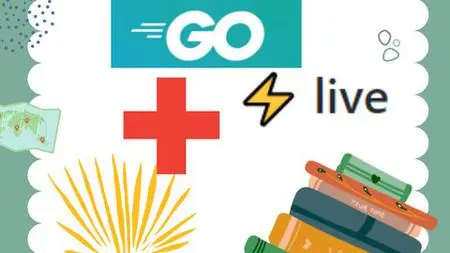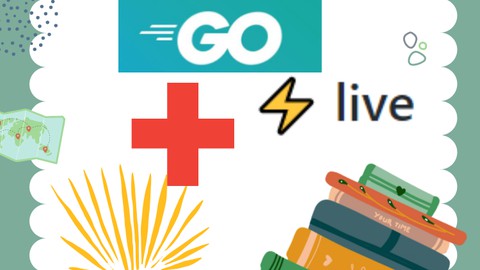Mastering Live(View) Development In Go (Golang)
Published 1/2023
MP4 | Video: h264, 1280x720 | Audio: AAC, 44.1 KHz
Language: English | Size: 1.74 GB | Duration: 4h 21m
Published 1/2023
MP4 | Video: h264, 1280x720 | Audio: AAC, 44.1 KHz
Language: English | Size: 1.74 GB | Duration: 4h 21m
Modern Phoenix LiveView inspired development in GoLang, where JS is no needed (almost).
What you'll learn
Real-time user experiences with server-rendered HTML
Phoenix(Elixir) LiveView like programming in Go
Form based UI using Live(View)
Pub/Sub based user communication using Live(View)
Periodic background jobs using Live(View)
Creating a single page application in one file
Integration with Fabric framework
Handling application events in declarative way
Using websocket communication between frontend and backed
Requirements
Basic programming skills in Go language
Description
Hello, welcome to the ‘Mastering Live(View) programming in Go’ course. With this course you are going to add a value to your existing Go Lang knowledge by getting familiar with several web development techniques known as a 'LiveView' programming model introduced within a last several years. We will focus on several topics popular when building web applications and we take a look on how to implement those features using a Live(View) techniques where JS usage is not needed or minimized at least. We are going to see how Live(View) programming approach makes web app development easier to do a more solution oriented. What is LiveVew programming approach / model?LiveView provides rich, real-time user experiences with server-rendered HTML. The LiveView programming model is mostly declarative: instead of saying "when event ABC happens, change XYZ on the page", events in LiveView are managed by handlers bound to event id. Once the state changes, LiveView will re-render the relevant parts of its HTML template(calculate diff) and push it to the browser, which updates itself in the most efficient manner. This means developers write LiveView templates as any other server-rendered HTML and LiveView does the hard work of tracking changes and sending the relevant diffs to the browser using websocket communication. This approach was widely popularized by Phoenix Framework and there are implementations for many major languages or platforms.Topics covered by this course:During a course we create basic web application in Go Lang with Live(View) approach. Main topics include:LiveView inspired programming - technical infoKey Live(View) concepts explainedThermostat - interactive application without JSImplementation of Pub/Sub communicationEnhancing thermostat - implementation of chat, clock, JS hooksLive(View) in popular frameworksIntegration of Live(View) application with NATS serverImportant part of this course is to realize 'what we don't need to do' when using Live(View) approach. Simplification can be huge and old saying that 'the best code is the code you don't have to write' proves here.Summary:The goal of this course is to make a guidance in Live(View) programming world. We use pragmatic approach by building real applications and exploring Live(View) programming model in practical way.GitHub repository:The source code is available through the link attached to the last lecture in this course. You can clone the repo and use the code snippets we are building in this course.
Overview
Section 1: Introduction
Lecture 1 Introduction
Section 2: LiveView inspired programming - technical info
Lecture 2 Application communication flow
Lecture 3 Websocket as a horse power
Section 3: Key Live(View) concepts explained
Lecture 4 Core minimum application structure
Lecture 5 Handling Events
Lecture 6 Using Params
Section 4: Thermostat - interactive application without JS
Lecture 7 Thermostat Feature Overview
Lecture 8 GoLang App - minimal setup
Lecture 9 Creating Live(View) application core
Lecture 10 Starting with Thermostat UI
Lecture 11 Mounting application to backend
Lecture 12 Side note: Where backend state is stored?
Lecture 13 Buttons and click events - part 1
Lecture 14 Buttons and click events - part 2
Lecture 15 What we are not doing?
Lecture 16 Getting and displaying the username
Lecture 17 Communicating the status to UI
Lecture 18 Overview
Section 5: Live with Pub/Sub - real-time communication
Lecture 19 Technical introduction
Lecture 20 Basic application setup updates
Lecture 21 Using Pub/Sub for communication for status updates
Lecture 22 Implementing status history updates
Lecture 23 What we are not doing
Section 6: Thermostat - adding a new features
Lecture 24 Adding a temperature warning
Lecture 25 Adding a clock
Lecture 26 Adding a chat like communication
Lecture 27 Working with custom JS using 'hooks'
Lecture 28 Managing temperature using a keyboard
Lecture 29 What we are not doing
Section 7: Live(View) with other popular frameworks
Lecture 30 Live(View) with Fiber Framework - part 1
Lecture 31 Live(View) with Fiber Framework - part 2
Lecture 32 Using Django compatible template engine
Section 8: Live(View) integration with NATS server (external Pub/Sub system or MQ)
Lecture 33 What is NATS Server
Lecture 34 Setting up an external NATS periodic message publisher
Lecture 35 NATS Go client setup
Lecture 36 Making a Live app receiving and displaying NATS data
For all existing or new Go programmers with an interest for LiveView like programming approach when building interactive applications easily.



